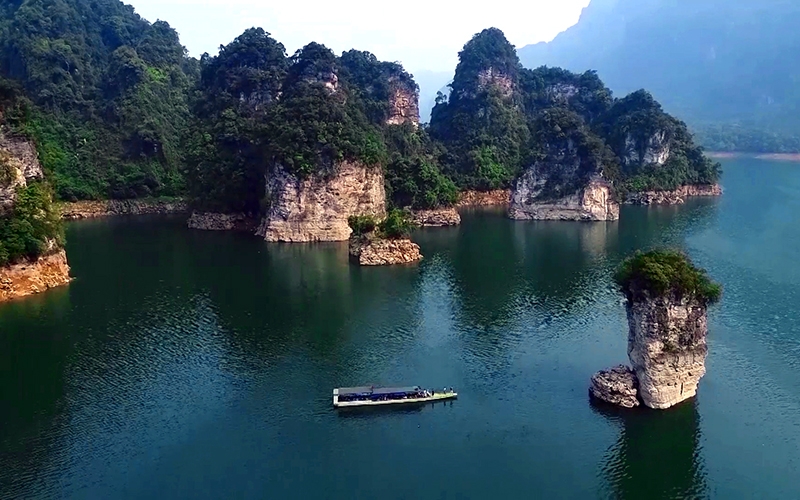From legend…
Being considered as the second Ha Long Bay, Lam Binh has great potential for tourism development.
Located on a limestone mountain in Khuon Ha Commune, Khuoi Pin Cave is 600 metres above sea level. From here, visitors can overlook a wide space of Tuyen Quang Lake. The cave, which has six compartments, is divided into two branches with a height of around 40 metres, width of around 200 metres and a depth of around 500 metres. The more than 10 huge stalactite columns inside the cave are like pillars supporting its arch. The cave is bigger inside with the sound of the water from the stalactites on the ceiling dropping down. The locals say that if those drops of water hit anyone, they will have good luck. Hundreds of stalactites hang down like a pristine relief with the ingenious arrangement of nature.
Standing at the entrance of Khuoi Pin Cave, visitors can also admire the Thuong Lam valley with 99 mountains and listen to the legend of phoenixes finding a place to build their nest here. The story is that, one day, the local people suddenly saw a flock of phoenixes fly to this land with each perching on a mountain. However, there were only 99 mountains, so one phoenix had to fly to the south and the 99 others followed it. Each mountain has a different shape, creating a vivid rocky population surrounding the Thuong Lam basin, inspiring the name “Ha Long among vast jungles”.
Khuon Ha Commune also possesses Nam Me Waterfall, which originates from the old forests at the top of the Gam River arc at an altitude of 1,600 m above sea level. The waterfall has 18 levels with total length of over 3,000 metres. From a distance, the waterfall looks like soft white silk among the green mountains and forests. Wild orchids grow on the old tree trunks or on the steep cliffs. Water flows through the smooth and round stones like a girl’s white skirt.

Kayak race on Tuyen Quang hydrolectric lake.
The story of today
In 2011, Lam Binh District was formed thanks to the merging of five communes of Na Hang District and three communes of Chiem Hoa District. 98% of the population in the mountainous district are from ethnic minority groups and the poverty rate was at over 70%. Despite its poetic landscapes, stretching mountains, fantastic caves and impressive stilt houses, the locals were still full of worries about poverty at that time.
How to develop economy and help local people escape from poverty have been always the concerns of the district’s Party committee and authorities. Therefore, the community-based tourism model (homestay) has been developed. A Phu Homestay in Na Tong Village, Thuong Lam Commune is a traditional stilt house of Tay ethnic minority people, with five spacious and airy compartments. Visitors can enjoy unique traditional food of ethnic minority groups, take baths with medicinal herbs and explore the hydroelectric lake. The homestay’s owner, Dang Van Anh, said that she has invited several local people who have an aptitude forThen singing and playing Tinh gourd lute to exchange with gusts. A Phu Homestay has created jobs for six people with an average income of VND5 million per person per month. According to Chau Minh Vy, his Anh The Homestay in Nam Dip Village, Lang Can Commune, has been in operation for four years and received a large number of both domestic and foreign visitors. He has used many popular materials, such as wood and bamboo, in his homestay; therefore, the guests have been very excited.
There are now 24 households investing in developing homestays in the communes of Thuong Lam, Lang Can and Khuon Ha. They have been equipped with standard equipment and can serve up to around 1,000 visitors each day. The locals have been trained with skills to serve visitors. In order to boost tourism development, especially the community-based tourism, the district’s agencies have guided local people and created favourable conditions for the households to have access to the banks’ capital so that they can build and decorate their houses as well as restore the traditional cultural values of ethnic minority groups. The district’s authorities have also mobilised residents to clean the roads to create green, clean and beautiful landscapes, while coordinating with the surrounding localities to develop attractive tours. The residential area in Ban Khien Village, Lang Can Commune, is being built into a service, culture and experience complex featuring a pedestrian street. Accordingly, in addition to homestay services and traveling on the lake, visitors can join cultural and sport activities as well as visit and buy souvenirs which are traditional handicrafts including brocades, bamboo and rattan products and agricultural specialties.
In particular, the ethnic minority groups in Lam Binh District have basically preserved their traditional cultural identities, from costumes, languages, customs, festivals, the architecture of their houses and folk song. Many traditional trade villages have attracted large numbers of visitors.

The Coc Vai tourist site on Tuyen Quang hydroelectric lake.
Currently, Lam Binh District is continuing to implement the project on “building and operating community-based tourism model”. Accordingly, the authorities focus on planning the residential areas in Nam Dip Village in Lang Can Commune and Na Tong Village in Thuong Lam Commune to become cultural villages in association with tourism development to preserve and sustainably develop the Tay ethnic minority cultural village. The journeys have been held for the households who have registered to open homestays to visit and learn experience in several other provinces. They have also joined training courses to improve their capacity and skills in community-based tourism. Many attractive tours and services have been developed to serve the guests in the district, such as kayaking, cycling, motorbike riding and fishing.
In order to sustainably develop community-based tourism, Lam Binh District will closely associate the environmental protection and promotion clean agricultural products with the preservation of cultural identities, embellishment of cultural and historical relics and landscapes and restoration of traditional festivals and trades. In addition, the local authorities will call for the households to preserve the unique cultural spaces of the ethnic minority groups; maintain the status quo of the landscapes and traditional architecture of the community-based tourist sites. Art groups will be formed in the villages to practice folk songs, dances, instruments and games; meanwhile, traditional rituals and costumes will be gradually restored in compliance with current regulations.
According to Nguyen Van Hien, who has been attached to this mountainous land for over 20 years, tourism has changed the locals’ thinking and created a new way in economic development, contributing to reducing the rate of poor households in Lam Binh District to just over 40%. The locality’s economic structure has been shifted from the development of infrastructure-agriculture-tourism into tourism-agriculture and infrastructure. The changes have made tourism into an important economic sector of Lam Binh.

Comment
Print